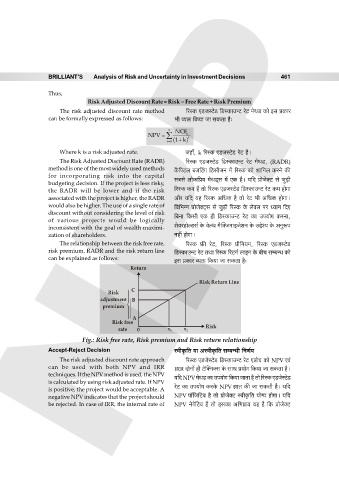Page 461 - Corporate Finance PDF Final new link
P. 461
NPP
BRILLIANT’S Analysis of Risk and Uncertainty in Investment Decisions 461
Thus,
Risk Adjusted Discount Rate = Risk – Free Rate + Risk Premium
The risk adjusted discount rate method [añH$ ES>OñQ>oS> {S>ñH$mCÝQ> aoQ> _oWS> H$mo Bg àH$ma
can be formally expressed as follows: ^r ì`º$ {H$`m Om gH$Vm h¡…
n NCF
NPV t t
t 0 1 k
Where k is a risk adjusted rate. Ohm±, k [añH$ ES>OñQ>oS> aoQ> h¡Ÿ&
The Risk Adjusted Discount Rate (RADR) [añH$ ES>OñQ>oS> {S>ñH$mCÝQ> aoQ> _oWS>, (RADR)
method is one of the most widely used methods H¡${nQ>b ~OqQ>J {S>grOZ _| [añH$ H$mo em{_b H$aZo H$s
for incorporating risk into the capital g~go bmoH${à` _oWS>²g _| EH$ h¡Ÿ& `{X àmoOoŠQ> go Ow‹S>r
budgeting decision. If the project is less risky,
the RADR will be lower and if the risk [añH$ H$_ h¡ Vmo [añH$ ES>OñQ>oS> {S>ñH$mCÝQ> aoQ> H$_ hmoJm
associated with the project is higher, the RADR Am¡a `{X `h [añH$ A{YH$ h¡ Vmo aoQ> ^r A{YH$ hmoJmŸ&
would also be higher. The use of a single rate of {d{^ÝZ àmoOoŠQ²>g go Ow‹S>r [añH$ Ho$ bodb na Ü`mZ {XE
discount without considering the level of risk {~Zm {H$gr EH$ hr {S>ñH$mCÝQ> aoQ> H$m Cn`moJ H$aZm,
of various projects would be logically
inconsistent with the goal of wealth maximi- eo`ahmoëS>g© Ho$ doëW _¡pŠO_mBOoeZ Ho$ CÔoí` Ho$ AZwê$n
zation of shareholders. Zht hmoJmŸ&
The relationship between the risk free rate, [añH$ \«$s aoQ>, [añH$ àr{_`_, [añH$ ES>OñQ>oS>
risk premium, RADR and the risk return line {S>ñH$mCÝQ> aoQ> VWm [añH$ [aQ>Z© bmBZ Ho$ ~rM gå~ÝY H$mo
can be explained as follows: Bg àH$ma ì`º$ {H$`m Om gH$Vm h¡…
Return
Risk Return Line
C
Risk
adjustment B
premium
A
Risk free
Risk
rate 0 x 1 x 2
Fig.: Risk free rate, Risk premium and Risk return relationship
Accept-Reject Decision ñdrH¥${V `m AñdrH¥${V gå~ÝYr {ZU©`
The risk adjusted discount rate approach [añH$ ES>OoñQ>oS> {S>ñH$mCÝQ> aoQ> EàmoM H$mo NPV Ed§
can be used with both NPV and IRR IRR XmoZm| hr Q>opŠZŠg Ho$ gmW à`moJ {H$`m Om gH$Vm h¡Ÿ&
techniques. If the NPV method is used, the NPV `{X NPV _oWS> H$m Cn`moJ {H$`m OmVm h¡ Vmo [añH$ ES>OoñQ>oS>
is calculated by using risk adjusted rate. If NPV
is positive, the project would be acceptable. A aoQ> H$m Cn`moJ H$aHo$ NPV kmV H$s Om gH$Vr h¡Ÿ& `{X
negative NPV indicates that the project should NPV nm°{O{Q>d h¡ Vmo àmoOoŠQ> ñdrH¥${V `mo½` hmoJmŸ& `{X
be rejected. In case of IRR, the internal rate of NPV ZoJo{Q>d h¡ Vmo BgH$m A{^àm` `h h¡ {H$ àmoOoŠQ>

